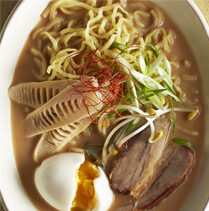For the pork belly: Preheat the oven to 300° F.
Set the pork belly, fat-side down on the work-surface. Roll into a cylinder and tie across the center and at both ends with butcher’s twine.
Heat the oil in a roasting pan over medium-high Add the leeks, garlic, and ginger and cook until softened and fragrant, 3 to 5 minutes. Whisk in the soy sauce, mirin, and hoisin. Set the pork belly, with its fattiest side up, in the liquid, adding water to bring the level half way up the roll. Bring the liquid to a boil, cover the top of the pan loosely with foil. Braise for 2 hours, baste the pork, braise for another hour, and then baste again. Continue to braise, basting every 15 minutes, until the pork is fork tender, about 1 hour more. Carefully remove the pork and set on a cooling rack.
The braising liquid can be reserved for another use. Strain, discard the solids, and skim off the fat. (Among other uses, the liquid will give a flavor boost to finished soups.)
Meanwhile for the broth and the eggs: Whisk together the soup mix and water in a soup pot over medium-high heat. Bring to a simmer and then reduce the heat to low. Add soy sauce to taste. Keep warm.
Fill a large bowl with ice water. Choose a sauté pan or shallow saucepan wide enough to hold the eggs in an even layer and add just enough water to cover them. Bring the water to a boil over high heat, gently set the eggs in the pan, and cook for 6 minutes. Immediately transfer the eggs to the ice water. Cool for a few minutes, crack on the wide rounded side (this accesses the air pocket separating the shell from the inner skin), and peel the eggs under the water (helps to remove the shell without damaging the white). Remove the eggs from the ice water. The eggs can be refrigerated for up to 24 hours, but should be brought to room temperature before adding to the soup.
To complete: Slice the pork, across the roll, into 3/8-inch slices.
For each serving: Twist about 2 ounces of the ramen noodles and nest in the bottom of a large soup bowl, preferably Asian-style. Arrange the pork slices over the ramen and ladle 10 ounces of broth into the bowl. Top with scallions, bean sprouts, and bamboo shoots (a generous tablespoon of each). Set an egg in the bowl, cut in half if desired, and garnish with the nori and chili threads.
*Ingredients available at Asian grocery stores and through specialty food distributors.


